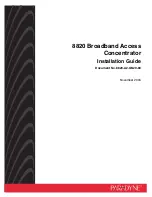
System Diagnostics
Page 52
FiberPatrol Site Planning & Installation Guide
If other equipment at the site is still communicating, but the FiberPatrol system is not, then it could
be a FiberPatrol system failure, requiring a site visit for further diagnostics.
Local Systems
Locally, the state of the system can be quickly assessed by checking the sensor unit Alarms
screen. The following are indications of a system malfunction:
•
Blank, blue, or frozen screen
•
Windows error messages
Any issues detected by self-diagnostics would be indicated in the System Status field:
•
Warning
•
Disarmed
•
Cable Cut
•
Head End alarms (current or recent)
If the system appears to be armed and operational, the following signs may indicate improper
system settings or calibration:
•
Failure to generate sensor alarms
•
Incorrect sensor alarm locations
Common Scenarios
Power surges and outages can temporarily disable security systems. They can also cause serious
equipment problems, especially if occurring often. FiberPatrol systems are configured to
automatically recover from a power outage. However, every time electronic and computer
equipment is hard-booted, there is the potential of an operating system or file structure corruption,
or hardware damage. Unstable line power is particularly dangerous as it may cause a rapid
succession of reboots that may leave equipment damaged or in an error state requiring a manual
reboot. A properly configured uninterruptable power supply (UPS) is recommended for use with
FiberPatrol head end equipment. Soft shutdown and remote reboot functionalities are also
strongly recommended.
Sensor unit crashes are rare occurrences for properly installed and configured equipment. Often
they are caused by external factors such as elevated operating temperature, unstable line power,
or improper handling of back panel cabling. Sensor unit hardware and software configuration are
stable under normal operating conditions. Intermittent or fatal crashes can be caused by a
hardware malfunction, such as a hard drive failure. Hardware failure is often a consequence of
abnormal operating conditions.
Unplugged, loose, or mishandled cables are a common cause of system downtime. Fiber-optic
jumpers, in particular, can be easily damaged when handled carelessly. Even power cables can be
incorrectly installed, or partially pulled out leaving them half-plugged and creating a spark gap.
Dirty single-mode fiber optic connectors are often to blame for optical losses in the system. Fiber
optic jumpers should not be disconnected, unless absolutely necessary. Unplugged fiber
connectors must be covered immediately with caps. The fiber connectors should always be
inspected and properly cleaned before they are plugged-in.
Swapped cables can cause error states that are difficult to diagnose. FiberPatrol head end
equipment uses two fiber optic jumpers to connect the system lead cable to the sensor unit. Refer
to the Site planning and installation guide for FiberPatrol Head End connection details.















































